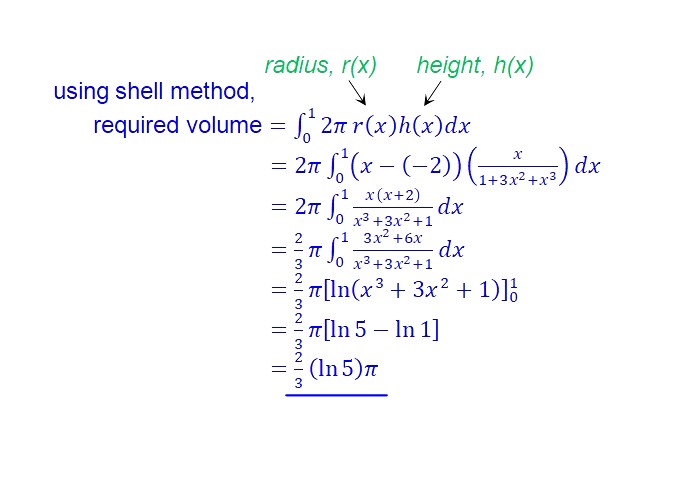Ask Singapore Homework?
Upload a photo of a Singapore homework and someone will email you the solution for free.

Question
junior college 2 | H3 Maths
One Answer Below
Anyone can contribute an answer, even non-tutors.

There’s 2 split curve, is there a way to even integrate? I nd help!
Translate the curve rightwards (in the direction of the x-axis) by 2 units so now the axis of rotation is the y-axis (i.e x = 0)
The lower bound is now 2 and the upper bound is 3.
Volume of revolution
= 2π ∫³₂ r(x) h(x) dx
= 2π ∫³₂ x · (x - 2) / (1 + 3(x - 2)² + (x - 2)³)) dx
= ⅔π ∫³₂ (3x² - 6x) / (1 + 3(x - 2)² + (x - 2)³) dx
Note : The expression is directly integrable since d/dx (1 + 3(x - 2)² + (x - 2)³)
= 6(x - 2) + 3(x - 2)²
= 3(2 + (x - 2))(x - 2)
= 3x(x - 2)
= 3x² - 6x
_____________________________________________
= ⅔π [ln(1 + 3(x - 2)² + (x - 2)³]³₂
= ⅔π [ln (1 + 3(3 - 2)² + (3 - 2)³) - ln (1 + 3(2 - 2)² + (2 - 2)³) ]
= ⅔π [ ln 5 - ln 1]
= ⅔π ln 5
See 1 Answer
base on the question description, the region to be rotated is only the portion between x=0 and x=1.
radius of the shell is taken as x+2 because the region is rotated around line x=-2.
height of the shell is just distance between curve and x-axis.
at first glance, the cubic denominator cannot factorise, but closer look shows that the numerator is just a multiple of the derivative of denominator, so it is simple integration here.
verified with GC. GC gives equivalent numerical value.





here, for the region from x=0 to x=1, x^3+3x^2+1 is positive.